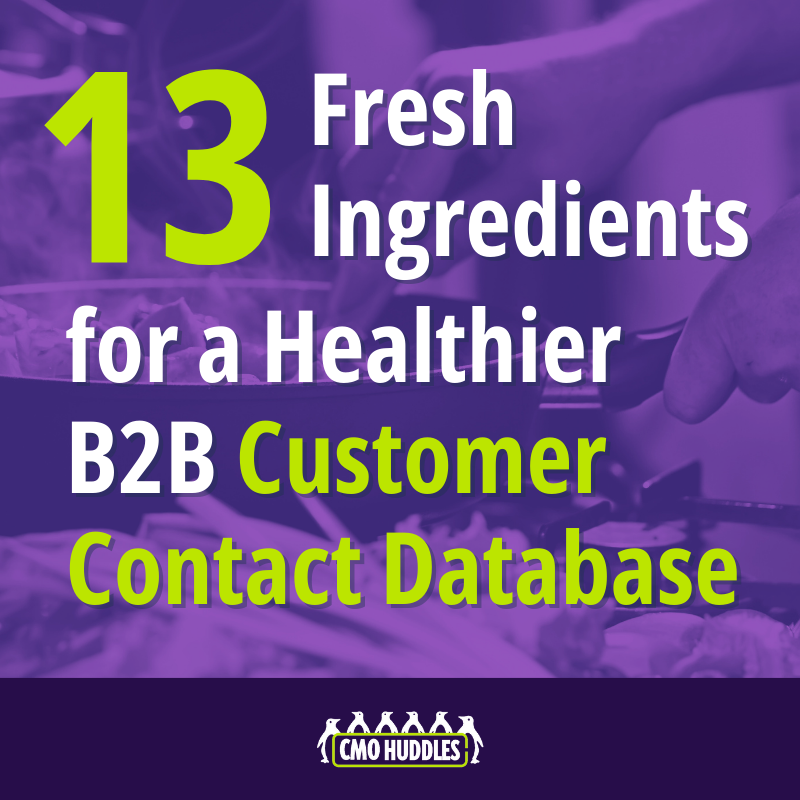As any good baker knows, quality ingredients make all the difference between a spectacular soufflé and a flat disappointment. The same principle applies to your B2B marketing efforts. Your customer contact database (CCD) is the primary ingredient in every campaign you bake up.
Unfortunately, a fresh-from-the-oven report from Repetitos and Boomerang reveals that most B2B companies are working with stale, poorly measured ingredients. After surveying 100 B2B companies, their "State of B2B Customer Contact Databases" research exposes a half-baked approach to database management that's costing companies revenue and customer engagement.
As a marketer who's helped hundreds of CMOs perfect their recipes for success, I'm serving up a baker's dozen insights every B2B CMO needs to digest about their customer contact database. Let's get cooking!
1. Your Database Is Half-Baked
The average Customer Contact Database health score across B2B companies is a mere 47% which is essentially a recipe for disaster.
As the report bluntly puts it: "If 47% was a semester's grade in high school, it might be time for a parent-teacher conference."
This is like trying to bake a soufflé with half the required ingredients. No matter how skilled your marketing team is, working with a database that's only 47% healthy means your campaigns are destined to fall flat.
2. Too Many Cooks, No Head Chef
The data shows organizations lack clear ownership of database management. About 35% assign responsibility to Customer Success, 30% to Revenue Operations, and 20% to Marketing Operations.
The report notes: "When asked, most departments say Customer Success Managers (CSMs) are responsible for updating the CCD. Almost all CSMs would reply that they can only keep track of the 1-2 people per account they regularly engage with."
Like a kitchen with no executive chef, this diffusion of responsibility means your database is being prepared without consistent standards or vision. Interestingly, when Customer Success takes the head chef role, the health score rises 7% compared to when RevOps is in charge.
3. Your Recipe Needs Cross-Functional Collaboration
Only 47% of companies have established a cross-functional group coordinating customer communications, yet this organizational structure produces significantly better results.
According to the authors, "High performers have a 22% better CCD health score than low performers. A formal group is one of the most impactful ways to impact the score."
Think of this as bringing together your pastry chefs, sous chefs, and bakers to ensure every aspect of your customer communications is perfectly balanced and complementary.
4. You're Using Basic Ingredients Instead of Gourmet Varieties
While 57% of companies segment by title, only 38% segment by post-sales roles. This represents using all-purpose flour when the recipe calls for specialty varieties.
The report states: "High performers rated their overall segmentation maturity at 55%. This is 20 percentage points better than low performers, making this a top priority to implement."
Advanced segmentation is like using distinct, high-quality ingredients that bring out specific flavors in your marketing creating experiences tailored to each customer's palate.
5. Your Pantry Needs Regular Restocking
Only 29% of companies updated and enriched their CCD in the past 6 months. Unfortunately, many respondents answered, "Don't know." Even if half of those did update their CCD, still less than 50% would have done so in the past 6 months.
The authors warn: "CCD's decay at a rate of 2% monthly. Therefore, it should be updated and enriched prior to the launch of a major campaign or annual event, and on a pre-determined cadence."
Would you bake with flour that's been sitting open in your pantry for six months? Database ingredients, like baking ingredients, need regular refreshing to maintain their effectiveness.
6. Your Rise Times Are Suffering
A shocking 60% of companies report email open rates below 30% for customer communications almost like a bread that refuses to rise properly.
The report offers a direct solution: "The quickest way to increase customer open rates by 5-10 percentage points is updating and enriching the database."
Before investing in exotic techniques and specialty equipment, ensure your basic ingredients are fresh and properly measured.
7. Ingredients Spoil Faster Than You Think
Based on the authors' experience working with clients, typically 20% of customer contacts have left their employer, 30% have a new title, and 40% a new location.
The report explains: "Employer and location are easy to interpret and add to the CRM. Titles can be challenging as they change more frequently, updates can be subtle (e.g. title inflation), and the value of similar titles are not uniform across industries."
This high rate of change is like dairy products spoiling in your refrigerator, if you don't check them regularly, you'll end up with curdled marketing campaigns.
8. Your Emergency Soufflé Plan Needs Work
While 73% of respondents claimed they could send a crisis communication from the CEO to main points of contact within a day, this capability depends entirely on your database quality.
The authors caution: "Hopefully, your company will never have to send one, but if you can't or the data is stale resulting in a subpar open rate, there will be some 'splaining' to do."
When a critical situation emerges, you need to be able to whip up an emergency response quickly not discover your ingredients are expired.
9. You're Throwing Away Perfectly Good Leftovers
Only 12% of vendors have a formal program to identify, nurture, and market to contacts who have left their employer. Even counting informal programs, the number only rises to 26%.
As Irwin Hipsman notes: "My last project at Forrester was a 60-day pilot to identify, nurture and incentivize contacts who left their company. Of the 200 leads, half landed at new employers and half were accepted. Three new deals were won during the pilot, with more in the pipeline."
These "alumni" contacts are like yesterday's bread: perfect for French toast if you know how to repurpose them, but most companies are simply tossing them in the trash.
10. Your Main Course Depends on Quality Ingredients
The research clearly shows that a healthy CCD impacts customer engagement (24%), renewal revenue (19%), and upsell revenue (17%).
The report highlights: "The classic use case is a key contact left the company. The renewals team finds out when it is too late and scramble to find a new contact."
No matter how skilled your chef, you can't serve a five-star meal with two-star ingredients. This direct link between database health and revenue should elevate database management to a priority ingredient in every CMO's kitchen.
11. Cross-Selling Is a Different Recipe Altogether
Cross-selling was identified as particularly challenging, with the report distinguishing it from upselling: "Forrester defines 'B2B cross-selling as a coordinated approach to generating demand within new buying centers, while upselling is a coordinated approach to generating demand within existing buying centers.'"
As one executive noted: "It's wild how often cross-sell and upsell get lumped together when they actually require totally different motions... Most teams I've worked with still treat it all under 'expansion' which creates messy handoffs."
This is like confusing a cookie recipe with a cake recipe: they may share similar ingredients, but the technique and execution are entirely different.
12. AI Can Be Your Master Chef's Assistant
The report mentions how AI can revolutionize database management: "AI is likely the one technology that will expose your data quality issues the most, which may help raise the awareness and urgency of dealing with your GTM data quality issues… Maybe this will finally make the executives care about and invest in data quality."
Think of AI as your sous chef, helping identify issues, enriching contacts, and providing insights that would be impossible to gather manually. Companies like Boomerang are using AI to automate database maintenance while providing valuable intelligence about contact movements.
13. Even a Slightly Better Recipe Makes a Huge Difference
Despite the current burnt edges of database management, there's hope: An improvement in CCD health score from 47% to 62% is achievable with moderate improvements.
As the authors emphasize: "Perfection is an illusion, and your health score won't be where you want it to be in a month or even a quarter. What separates the high performers from the rest is their commitment to a journey of incremental improvements."
You don't need to become a Michelin-star database chef overnight. Even improving a few key ingredients and techniques can dramatically enhance your marketing menu.
The Master Recipe for Success
As third-party cookies crumble and privacy regulations tighten your first-party data becomes increasingly valuable. Yet most companies are neglecting this crucial ingredient in their marketing pantry.
Marketing consultant Pamela Parker is quoted in the report: "Successful organizations will be the ones that treat data enrichment and hygiene as strategic, ongoing commitments rather than sporadic fixes. By maintaining accurate, up-to-date datasets, marketers gain the insights needed to...strengthen customer relationships and position themselves to thrive in a privacy-first, AI-driven future."
It's time for CMOs to elevate database health from a back-burner side dish to the main course. The companies that perfect this recipe will feast on competitive advantage while others are left with a bad taste in their mouths.
About the Chefs (i.e. Authors of the Report)
Irwin Hipsman is a 3x salesperson, 2x manager of customer success teams, and 4x customer marketing leader. He founded Repetitos to help transform clients' customer contact databases into an advantage by updating and enriching customer contact databases, delivering live online workshops, designing "Repeat Sales by Former Customer Contact" programs, and writing bespoke research reports.
Shankar Ganapathy is the leader of Boomerang, an AI-powered revenue platform that empowers revenue teams to accelerate growth. By leveraging job change tracking and AI-driven insights, Boomerang helps companies like Armis, Informatica, and Litera achieve significant ROI (10-50x). Key use cases include job change tracking, CRM optimization, and facilitating warm introductions to executives.
Boomerang is a Founding Sponsor of the CMO Super Huddle, which is limited to 101 B2B marketing leaders. Early bird tickets are now available.

